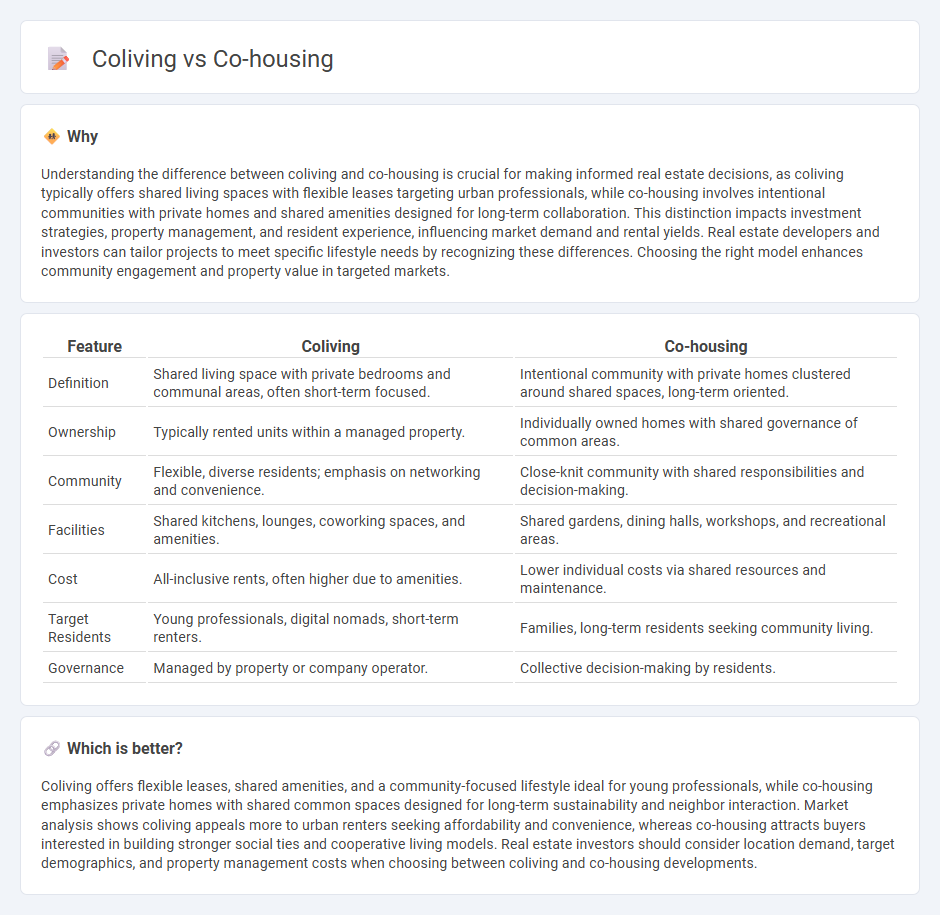
Coliving spaces offer private bedrooms with shared common areas, appealing to urban professionals seeking flexibility and convenience, while co-housing communities emphasize collaborative living with shared resources and communal decision-making. Real estate trends show coliving properties growing rapidly in major cities due to increasing demand for affordable, flexible housing options. Explore the key differences and benefits of coliving versus co-housing to choose the ideal living arrangement for your lifestyle.
Why it is important
Understanding the difference between coliving and co-housing is crucial for making informed real estate decisions, as coliving typically offers shared living spaces with flexible leases targeting urban professionals, while co-housing involves intentional communities with private homes and shared amenities designed for long-term collaboration. This distinction impacts investment strategies, property management, and resident experience, influencing market demand and rental yields. Real estate developers and investors can tailor projects to meet specific lifestyle needs by recognizing these differences. Choosing the right model enhances community engagement and property value in targeted markets.
Comparison Table
| Feature | Coliving | Co-housing |
|---|---|---|
| Definition | Shared living space with private bedrooms and communal areas, often short-term focused. | Intentional community with private homes clustered around shared spaces, long-term oriented. |
| Ownership | Typically rented units within a managed property. | Individually owned homes with shared governance of common areas. |
| Community | Flexible, diverse residents; emphasis on networking and convenience. | Close-knit community with shared responsibilities and decision-making. |
| Facilities | Shared kitchens, lounges, coworking spaces, and amenities. | Shared gardens, dining halls, workshops, and recreational areas. |
| Cost | All-inclusive rents, often higher due to amenities. | Lower individual costs via shared resources and maintenance. |
| Target Residents | Young professionals, digital nomads, short-term renters. | Families, long-term residents seeking community living. |
| Governance | Managed by property or company operator. | Collective decision-making by residents. |
Which is better?
Coliving offers flexible leases, shared amenities, and a community-focused lifestyle ideal for young professionals, while co-housing emphasizes private homes with shared common spaces designed for long-term sustainability and neighbor interaction. Market analysis shows coliving appeals more to urban renters seeking affordability and convenience, whereas co-housing attracts buyers interested in building stronger social ties and cooperative living models. Real estate investors should consider location demand, target demographics, and property management costs when choosing between coliving and co-housing developments.
Connection
Coliving and co-housing both emphasize shared living spaces that foster community interaction and resource efficiency within real estate development. These models reduce individual housing costs while promoting social connectivity through common areas and collaborative decision-making. Integrating coliving and co-housing concepts supports sustainable urban growth by optimizing land use and enhancing residents' quality of life.
Key Terms
Shared Ownership
Co-housing emphasizes shared ownership of private and communal spaces, fostering a collaborative community where residents actively participate in decision-making and property management. Coliving typically involves renting private rooms with shared amenities, prioritizing convenience and flexibility over property investment. Explore the differences between co-housing and coliving to find the best fit for your lifestyle and housing goals.
Communal Spaces
Co-housing communities typically feature private homes clustered around shared communal spaces such as kitchens, gardens, and recreation areas, fostering strong neighborly interactions and collaborative living. Coliving spaces emphasize flexible, fully furnished units with extensive shared amenities like coworking spaces, lounges, and communal dining areas designed to accommodate transient lifestyles and promote social networking. Explore further to understand how these living arrangements optimize communal environments to suit diverse resident needs.
Private Units
Private units in co-housing typically feature fully self-contained apartments or homes, offering residents greater privacy and personalized living spaces. Coliving arrangements often include smaller private bedrooms complemented by extensive shared common areas designed to foster community interactions. Explore the unique benefits and design aspects of private units in co-housing and coliving to find the best fit for your lifestyle needs.
Source and External Links
Cohousing - Cohousing is an intentional, self-governing community where residents live in private homes with shared spaces to promote social interaction and collaborative living.
Housing Co-ops - Housing cooperatives are corporations formed for providing housing to members, characterized by member ownership and control.
River Song Cohousing - River Song Cohousing offers a blend of private homes and shared spaces, fostering a close-knit community with access to natural surroundings.
 dowidth.com
dowidth.com